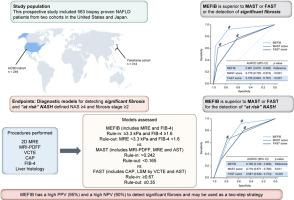Journal of Hepatology ( IF 25.7 ) Pub Date : 2022-08-13 , DOI: 10.1016/j.jhep.2022.07.020 Beom Kyung Kim 1 , Nobuharu Tamaki 2 , Kento Imajo 3 , Masato Yoneda 4 , Nancy Sutter 5 , Jinho Jung 5 , Tuo Lin 6 , Xin M Tu 6 , Jaclyn Bergstrom 5 , Khang Nguyen 5 , Leyna Nguyen 5 , Tracy Le 5 , Egbert Madamba 5 , Lisa Richards 5 , Mark A Valasek 7 , Cynthia Behling 8 , Claude B Sirlin 9 , Atsushi Nakajima 4 , Rohit Loomba 10

|
Background & Aims
Patients with non-alcoholic fatty liver disease (NAFLD) and significant fibrosis (fibrosis stage ≥2) are candidates for pharmacological trials. The aim of this study was to perform a head-to-head comparison of the diagnostic test characteristics of three non-invasive stiffness-based models including MEFIB (magnetic resonance elastography [MRE] plus FIB-4), MAST (magnetic resonance imaging [MRI]-aspartate aminotransferase [AST]), and FAST (FibroScan-AST) for detecting significant fibrosis.
Methods
This prospective study included 563 patients with biopsy-proven NAFLD undergoing contemporaneous MRE, MRI proton density fat fraction (MRI-PDFF) and FibroScan from two prospective cohorts derived from Southern California and Japan. Diagnostic performances of models were evaluated by area under the receiver-operating characteristic curve (AUC).
Results
The mean age of the cohort was 56.5 years (51% were women). Significant fibrosis was observed in 51.2%. To detect significant fibrosis, MEFIB outperformed both MAST and FAST (both p <0.001); AUCs for MEFIB, MAST, and FAST were 0.901 (95% CI 0.875–0.928), 0.770 (95% CI 0.730–0.810), and 0.725 (95% CI 0.683–0.767), respectively. Using rule-in criteria, the positive predictive value of MEFIB (95.3%) was significantly higher than that of FAST (83.5%, p = 0.001) and numerically but not statistically greater than that of MAST (90.0%, p = 0.056). Notably, MEFIB’s rule-in criteria covered more of the study population than MAST (34.1% vs. 26.6%; p = 0.006). Using rule-out criteria, the negative predictive value of MEFIB (90.1%) was significantly higher than that of either MAST (69.6%) or FAST (71.8%) (both p <0.001). Furthermore, to diagnose “at risk” non-alcoholic steatohepatitis defined as NAFLD activity score ≥4 and fibrosis stage ≥2, MEFIB outperformed both MAST and FAST (both p <0.05); AUCs for MEFIB, MAST, and FAST were 0.768 (95% CI 0.728–0.808), 0.719 (95% CI 0.671–0.766), and 0.687 (95% CI 0.640–0.733), respectively.
Conclusions
MEFIB was better than MAST and FAST for detection of significant fibrosis as well as “at risk” NASH. All three models provide utility for the risk stratification of NAFLD.
Lay summary
Non-alcoholic fatty liver disease (NAFLD) affects over 25% of the general population worldwide and is one of the main causes of chronic liver disease. Because so many individuals have NAFLD, it is not practical to perform liver biopsies to identify those with more severe disease who may require pharmacological interventions. Therefore, accurate non-invasive tests are crucial. Herein, we compared three such tests and found that a test called MEFIB was the best at detecting patients who might require treatment.
中文翻译:

MEFIB、MAST 和 FAST 之间用于检测 NAFLD 患者 2 期或更高阶段纤维化的直接比较
背景与目标
患有非酒精性脂肪性肝病 (NAFLD) 和显着纤维化(纤维化分期≥2)的患者是药理学试验的候选对象。本研究的目的是对三种基于刚度的非侵入性模型的诊断测试特征进行面对面比较,包括 MEFIB(磁共振弹性成像 [MRE] 加 FIB-4)、MAST(磁共振成像 [ MRI]-天冬氨酸氨基转移酶 [AST]) 和 FAST (FibroScan-AST) 用于检测显着纤维化。
方法
这项前瞻性研究包括来自南加州和日本的两个前瞻性队列的 563 名经活检证实的 NAFLD 患者,他们同时接受了 MRE、MRI 质子密度脂肪分数 (MRI-PDFF) 和 FibroScan。通过接受者操作特征曲线 (AUC) 下的面积评估模型的诊断性能。
结果
该队列的平均年龄为 56.5 岁(51% 为女性)。51.2% 的患者观察到明显的纤维化。为了检测显着纤维化,MEFIB 优于 MAST 和 FAST(均p <0.001);MEFIB、MAST 和 FAST 的 AUC 分别为 0.901 (95% CI 0.875–0.928)、0.770 (95% CI 0.730–0.810) 和 0.725 (95% CI 0.683–0.767)。使用纳入标准,MEFIB (95.3%) 的阳性预测值显着高于 FAST (83.5%,p = 0.001),并且在数值上但不高于 MAST (90.0%,p = 0.056)。值得注意的是,MEFIB 的纳入标准涵盖的研究人群比 MAST 多(34.1%对26.6%;p =0.006)。使用排除标准,MEFIB (90.1%) 的阴性预测值显着高于 MAST (69.6%) 或 FAST (71.8%)(均p < 0.001)。此外,为了诊断定义为 NAFLD 活动评分≥4 和纤维化分期≥2 的“有风险”非酒精性脂肪性肝炎,MEFIB 优于 MAST 和 FAST(均p < 0.05);MEFIB、MAST 和 FAST 的 AUC 分别为 0.768 (95% CI 0.728–0.808)、0.719 (95% CI 0.671–0.766) 和 0.687 (95% CI 0.640–0.733)。
结论
MEFIB 在检测显着纤维化和“有风险的”NASH 方面优于 MAST 和 FAST。这三种模型都为 NAFLD 的风险分层提供了实用性。
外行总结
非酒精性脂肪性肝病 (NAFLD) 影响全球 25% 以上的总人口,是慢性肝病的主要原因之一。由于有如此多的人患有 NAFLD,因此通过肝活检来识别那些可能需要药物干预的病情更严重的人是不切实际的。因此,准确的无创测试至关重要。在此,我们比较了三种此类测试,发现名为 MEFIB 的测试最适合检测可能需要治疗的患者。


























 京公网安备 11010802027423号
京公网安备 11010802027423号